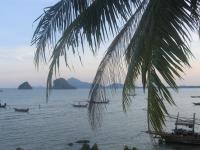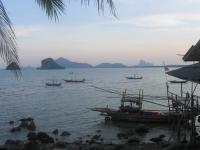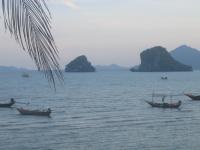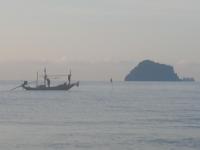
timber
-
Posts
836 -
Joined
-
Last visited
Content Type
Events
Forums
Downloads
Quizzes
Gallery
Blogs
Posts posted by timber
-
-
Here is another bandwidth check. Not that sure how it compares with the one we have been using yet. Maybe those with more computer savey can comment.
http://www.abeltronica.com/velocimetro/pt/...a=uk&newlang=uk
-
I think you would have some real problems mixing rubber and oil palm. Better to plant half oil palm and half rubber as per area.
-
-
I am from the bush in British Columbia. We have just a small area of plantation and the wife's sister and brother have plantations near Chumphon. Have lots of relatives with plantations also. They're making pretty good money right now off of rubber. Her sister is getting over 20,000 baht per month on 7 rai with more coming on stream in a couple of years. A lot of problems with thai's planting on rice fields. They think that because they can see water the trees should be ok. A good drip irrigation system is a good idea. You can kill two birds. Controlled water and fertiliziation. You will pay for it on a good site with increase in production at today's prices. Use some common sense and do some homework on the internet. Normally the advice you will get is marginally. You normally have to dig drainage ditiches to keep the water table down a lot of the year. That then draines the raised land too much the rest of the year.
-
[quote name='Ramses'
Thanks for the site Ramses. Yeah, just went there for a holiday and
to see mother. I forget how clean and pure it is there. With the resource
economy going wild lots of money to be made for at least 5 years.
-
A few years ago I found a problem doing that with Coral Draw. When I did that with Photo shop no problem getting a good jpeg
-
I would like to know if there is a site also. I just call up the sister-in-law to find out. You are right it is around 100 baht per kg now. Rubber trees and oil palm have always been a tough decision to make on what to plant. The prices between them used to go up and down a lot. Once the Thai government gets its act together the oil palm price should go up. I don't think the Thai government has a lot of knowledge about oil palm or biodiesel. China is planting lots of rubber tree plantations although it isn't the best place to grow rubber. The need for rubber is growing dramatically in both India and China so you can't go wrong. Just be careful about getting too big too fast without control. As a matter of course you will have to put a lot of trust in other people, and their priorities
may be different than yours.
-
Artificial reefs have been quite sucessful. We had one done near where I lived in Canada. Every project has objects and hopefully it is for the environment and not carbage disposal.
-
China into rubber
China emerging a key rubber producer in AsiaAravindan
Kottayam , Feb. 11
FROM an average rubber producer a few years ago, China has now emerged as a leading rubber-producing country in Asia with a total planted area of 625,600 hectares under rubber and production of around 500,000 tonnes in 2003 according to Mr Thomas Ouseph , a senior rubber consultant and former Secretary of Rubber Board.China is the fifth largest rubber producer in the world after India, which produced 670,000 tonnes during the year with a total planted area of 570,000 hectares, he said.
Though there are many favourable factors for rubber cultivation, Chinese production is low compared to India mainly on account of cold climate and frequent occurrence of typhoons. While the cold climate retards plant growth, typhoons cause trunk and branch snaps and even uprooting the whole tree at times.
Speaking to Business Line Mr Ouseph, who recently returned from China after a study tour, said Chinese average productivity of rubber at 1140 kg per hectare is low compared to India's 1575 kg, but it is better than Indonesia's 700 kg, mainly on account of systematic planting and better plantation maintenance. Though China has developed cold resistant variety of rubber plants, these occupy only about 1 per cent of the planted area as the productivity is low. Major clones planted are the Malaysian clone RRIM 600 and the Indonesia clones PR 107 and GT1.
-
Jeff - It sounds like a good price. As long as it isn't on a rocky hill top. Rubber normally starts producing around 7 seven years and yields increase to 10 or 12. The price is about a 100 baht per kg right now. The future for rubber looks pretty good for at lease 10 years. India and China's needs for rubber is growing. Only downside is that there isn't enough rubber and come up with a substitute. You are good for a while. You will need someone to harvest and it seems like you have that under control. The harvester processer generally gets about 50% of the take. If you have reasonable land you can gross around 3000 baht per rai. There are lots of down days. These are all estimates and there are ways to increase and decrease produtuction.
Hey everyoneIm new to this and would appreciate any advice you may have.
I have just bought 15 ri in Nong Yow (300.000 bht), 8 Ri have rubber trees at 4 year old. My partner’s father owns 35 ri and he will look after our 15. My partner has 5 ri all with trees 5 yo. She has been telling me to invest in the rubber tree industry. I have done it now, did I get a good deal? Can I make money?
Thanks
Jeff
-
There are major flood warnings for september october and ever more so in november due to La Nina.
-
I think the Drought Warning system would be like the flood warning system. A serious of towers costing 10 million babt per tower.
-
This is a fairly detailed site on the growing of rubber in India.
-
Dengue Bulletin – Vol 27, 2003 197
Potential of Rubber Plantations as Breeding Source for
Aedes albopictus in Kerala, India
by
P K Sumodan#
Post Graduate Department of Zoology, Government College, Madappally, Vadakara-2, Kerala, India
# For correspondence: [email protected]
Introduction
Ever since the major outbreak of DF/DHF during 1996 in Delhi(1), dengue fever has
been receiving manifold attention from health authorities and researchers all over
India. For the first time, one imported dengue case was reported in Wayanad
district of Kerala and a death due to suspected dengue haemorrhagic fever in the
neighbouring Kannur district in June 2002. Vector surveys in localities associated with
these cases indicated that the dominant breeding site for Aedes albopictus, the
second most important dengue vector(2), was artificial containers used for collecting rubber
sap. During the south-western monsoon(June-September) season, it is a practice to
suspend tapping temporarily in some plantations leading to accumulation of
rainwater in these containers, thus providing ideal breeding sites for mosquitoes. Against
this backdrop a systematic study to substantiate the potential of rubber
plantations as sources for the proliferation of Aedes albopictus was conducted in three
villages each in Kannur and Wayanad districts from July to September 2002.
Kannur and Wayanad are two neighbouring districts in north Kerala.
Kannur district has 57,823 rubber plantations of different sizes occupying a total area of
33,944 hectares, while Wayanad has 10,244 rubber plantations occupying 6,450
hectares. The two districts receive on an average 300 mm of annual rainfall
Two categories of rubber plantations were selected for the study. They were
(i) with active tapping using rain guards; and(ii) where tapping was suspended with sapcollecting
containers intact but without rain guards. Ten plantations each were selected
under each category from both districts. In each plantation, 100 trees were surveyed at
random for mosquito breeding. Immature stages of mosquitoes were collected in
plastic containers and transported to the laboratory for emergence and identification
.
Potential of Rubber Plantations as Breeding Source for Aedes albopictus in Kerala, India
198 Dengue Bulletin – Vol 27, 2003
Results and discussions
In both districts the plantations with active rubber tapping, no sap-collecting containers
were found to be having rainwater. However, in the plantations where tapping
had been suspended, sap-collecting containers had rainwater collection and also
mosquito breeding (Table). In Kannur district, of the 1,000 trees surveyed, 802
(80.2%) had sap-collecting containers with rainwater. A total of 788 (98.3%) of these
containers were positive for Aedes albopictus breeding in association with other Aedine sp.
This species constituted 23.2% of the adult mosquitoes that emerged in the laboratory.
In Wayanad district, 917 out of 1,000 trees surveyed had sap-collecting containers with
water. However, only 807 (88.0%) supported mosquito breeding. Breeding of
Aedes albopictus was found only in 534(58.2%) containers. The percentage of Aedes
albopictus adults that emerged in the laboratory was 12.8%. On an average, each
hectare of rubber plantations had 330 trees. The capacity of a sap-collecting container was 500 ml.
This study emphatically indicates the potential of rubber plantations as important
sources for the proliferation of Aedes albopictus. In view of the fact that rubber
plantations play a significant role in the economy of the region, increased contact of
the human population with Aedes albopictus acquires greater epidemiological importance.
The study also revealed that those plantations where tapping was not
abandoned during the rainy season did not have any potential for mosquito breeding.
This is a positive aspect of the entire issue, as encouraging rubber tapping during the rainy
season using rain guards could be one of the most plausible solutions for the problem.
Acknowledgements
The author is thankful to the Director of Health Services, Kerala, for providing the
necessary facilities and to Mr CM Vinod, District Malaria Officer, Kannur, for his
assistance in carrying out the study. He is also grateful to the Rubber Board authorities
at Kottayam for providing facilities for the conduct of the study.
References
1. Anuradha S, Singh NP, Rizvi SN, Agarwal SK, Gur R
and Mathur MD. The 1996 outbreak of dengue
haemorrhagic fever in Delhi, India. South-East Asian
J Trop Med Public Health, 1998, 29(3): 503-506.
2. Shroyer DA. Aedes albopictus and arboviruses: A
concise review of the literature. J Am Mosq
Control Assoc, 1987, 2: 424-428.
-
Dengue Bulletin – Vol 27, 2003 197
Potential of Rubber Plantations as Breeding Source for
Aedes albopictus in Kerala, India
by
P K Sumodan#
Post Graduate Department of Zoology, Government College, Madappally, Vadakara-2, Kerala, India
# For correspondence: [email protected]
Introduction
Ever since the major outbreak of DF/DHF during 1996 in Delhi(1), dengue fever has
been receiving manifold attention from health authorities and researchers all over
India. For the first time, one imported dengue case was reported in Wayanad
district of Kerala and a death due to suspected dengue haemorrhagic fever in the
neighbouring Kannur district in June 2002. Vector surveys in localities associated with
these cases indicated that the dominant breeding site for Aedes albopictus, the
second most important dengue vector(2), was artificial containers used for collecting rubber
sap. During the south-western monsoon(June-September) season, it is a practice to
suspend tapping temporarily in some plantations leading to accumulation of
rainwater in these containers, thus providing ideal breeding sites for mosquitoes. Against
this backdrop a systematic study to substantiate the potential of rubber
plantations as sources for the proliferation of Aedes albopictus was conducted in three
villages each in Kannur and Wayanad districts from July to September 2002.
Kannur and Wayanad are two neighbouring districts in north Kerala.
Kannur district has 57,823 rubber plantations of different sizes occupying a total area of
33,944 hectares, while Wayanad has 10,244 rubber plantations occupying 6,450
hectares. The two districts receive on an average 300 mm of annual rainfall
Two categories of rubber plantations were selected for the study. They were
(i) with active tapping using rain guards; and(ii) where tapping was suspended with sapcollecting
containers intact but without rain guards. Ten plantations each were selected
under each category from both districts. In each plantation, 100 trees were surveyed at
random for mosquito breeding. Immature stages of mosquitoes were collected in
plastic containers and transported to the laboratory for emergence and identification
.
Potential of Rubber Plantations as Breeding Source for Aedes albopictus in Kerala, India
198 Dengue Bulletin – Vol 27, 2003
Results and discussions
In both districts the plantations with active rubber tapping, no sap-collecting containers
were found to be having rainwater. However, in the plantations where tapping
had been suspended, sap-collecting containers had rainwater collection and also
mosquito breeding (Table). In Kannur district, of the 1,000 trees surveyed, 802
(80.2%) had sap-collecting containers with rainwater. A total of 788 (98.3%) of these
containers were positive for Aedes albopictus breeding in association with other Aedine sp.
This species constituted 23.2% of the adult mosquitoes that emerged in the laboratory.
In Wayanad district, 917 out of 1,000 trees surveyed had sap-collecting containers with
water. However, only 807 (88.0%) supported mosquito breeding. Breeding of
Aedes albopictus was found only in 534(58.2%) containers. The percentage of Aedes
albopictus adults that emerged in the laboratory was 12.8%. On an average, each
hectare of rubber plantations had 330 trees. The capacity of a sap-collecting container was 500 ml.
This study emphatically indicates the potential of rubber plantations as important
sources for the proliferation of Aedes albopictus. In view of the fact that rubber
plantations play a significant role in the economy of the region, increased contact of
the human population with Aedes albopictus acquires greater epidemiological importance.
The study also revealed that those plantations where tapping was not
abandoned during the rainy season did not have any potential for mosquito breeding.
This is a positive aspect of the entire issue, as encouraging rubber tapping during the rainy
season using rain guards could be one of the most plausible solutions for the problem.
Acknowledgements
The author is thankful to the Director of Health Services, Kerala, for providing the
necessary facilities and to Mr CM Vinod, District Malaria Officer, Kannur, for his
assistance in carrying out the study. He is also grateful to the Rubber Board authorities
at Kottayam for providing facilities for the conduct of the study.
References
1. Anuradha S, Singh NP, Rizvi SN, Agarwal SK, Gur R
and Mathur MD. The 1996 outbreak of dengue
haemorrhagic fever in Delhi, India. South-East Asian
J Trop Med Public Health, 1998, 29(3): 503-506.
2. Shroyer DA. Aedes albopictus and arboviruses: A
concise review of the literature. J Am Mosq
Control Assoc, 1987, 2: 424-428.
-
An interesting plant species that is trouted in India is Jatropha curcas. It has about 1/3 the productivity of oil palm, but can do quite nicely on harsher sites. Oil palm is greedy for fertilizer and water. Harsher site should involve a lot less capital in buying land.
-
For some odd reason California has made it difficult for bio-diesel in the state so this story is interesting.
"A biodiesel fuel coop in California has opened a pump that will sell a high blend of biodiesel made from California walnut oil. The USA Palisades Gas & Wash in Pacific Palisades is the first station in Los Angeles County with B99.9 at the retail pump. It opened on National Biodiesel Day, March 18.
The fuel is retailing at $3.49 per gallon. It is produced by Imperial Western Products, a California company that recently became an accredited producer under the industry’s quality assurance program.
“We are nuts about this pump,” said Kent Bullard, co-founder of the Los Angeles Biodiesel Coop. “It’s a local venture for our community. Locally available fuel at the commercial pump, made from local agricultural oils and locally manufactured. It doesn’t get any better than this.”
The station is open seven days a week, 8 a.m. to 6 p.m., but as required by the station’s variance, sales will only be authorized to members of the Los Angeles Biodiesel Coop or to members of the Southern California Biodiesel Users Group.
For more, visit http://www.biodiesel-coop.org. To see other pumps nationwide, visit http://www.biodiesel.org/buyingbiodiesel/r...ingsites."
-
Some major sun spots forcaste the latter part of 2007 so this may be a problem with reception.
-
The return you will get on planting rubber trees have a few variables.
1. What is the land cost - (15,000-80,000 baht per rai)
2. What is the site good or bad (may make a big difference in latex production)
3. Investment to grow. Land clearing, irrigation, fertilization, silviculture.
4. You will most likely have someone tap the rubber for you. They will expect 50% - 60% of the return on the rubber.
5. Forgot cost of trees and planting.
6. Cost of money over the first 5 - 6 years. (no revenue)
Hmmm.... wild guess. return 3,000 baht gross revenue per rai. (before costs)
-
Rishi
A pretty good site. It seems to cover most of the bells and whistles involved in a non-Thai being in Thailand.
Thanks a lot
-
Our school has those days scheduled for holidays. (no school)
-
There is lots but more of a family thing. Everything is pretty spread out. Will be a bit nicer when the new mall is done then a theater close. The hospital past big "C' has been good. Bit high on pills.
Mentioned?
Easy Pezy
Country Club etc.
And as you said can take the van into town for 25 baht which takes 25 minutes and take a taxi home.
-
Yes it is a bit shocking, The B.C. ferry system has a good safety record and they have a lot of ships in some pretty roughed area. Very unusual form them to have problems let along a sinking.
Published: Wednesday, March 22, 2006
PRINCE RUPERT, B.C. -- Grateful survivors of today's ferry sinking off the Queen Charlotte Islands are telling graphic stories of their ill-fated journey. Passenger Lawrence Papineau, one of the 100 people who took to lifeboats in choppy seas, says it was like a scene out of the Titanic.
He says passengers heard a crashing noise, then the 125-metre ship tilted to one side. Within an hour, Papineau says the vessel tilted again and levelled out before it "sank down to the sixth deck, came up like the Titanic, dipped and then it went under."
The orderly rescue of dozens of people from the ferry's lifeboats -- 42 crew members and 59 passengers -- and the fact that no one was seriously injured is nothing short of miraculous, said the president of B.C. Ferries.
"Anytime you have a major incident and you have no one hurt or killed in this type of thing, I think you always think it's a miracle," David Hahn said. "You always think, thank God, and you (are) thankful for the crew. That's what they're trained to do. They've done their job once again."
The Queen of the North, sailing south on a 450-kilometre overnight trip from Prince Rupert to Port Hardy along what's known as B.C.'s Inside Passage, hit the rock in choppy seas and high winds. It took about an hour for the boat to sink, allowing those aboard the ferry to get on the lifeboats and giving rescuers time to reach them.
The Sir Wilfrid Laurier, which was in the area and on the scene by 2:10 a.m., and a fishing boat from Hartley Bay, the Lone Star, were instrumental in the rescue.
The Lone Star, in fact, "played a very valuable role" by pulling passengers from the life rafts and taking them to the Hartley Bay community centre, Canadian Coast Guard spokesman Dan Bate said. Other residents of Hartley Bay took speedboats out to the site of the incident to help rescue passengers.
Local community offers comfort
Most of those rescued from the lifeboats were taken to a community centre in Hartley Bay where the town's residents brought them blankets and coffee; the others were still aboard the Sir Wilfrid Laurier. They were all to be taken to Prince Rupert later Wednesday.
Some of the passengers were in their nightclothes when rescued. The ferry left Prince Rupert at 8 p.m. PST Tuesday and wasn't due to arrive in Port Hardy until noon Wednesday.
The 125-metre-long vessel was completely submerged about 135 kilometres from Prince Rupert after hitting the rock, listing to one side and then sinking.
"It's unfortunate to lose the ship, but if that's the cost of having nobody really hurt or killed, then fine, I think we'll live with that," Hahn said.
Hahn and B.C. Premier Gordon Campbell were headed to Prince Rupert to meet with those rescued from the ferry. An eight-member team from the Transportation Safety Board was also due in the area later in the day.
Nicole Robinson, a receptionist at the nursing station in Hartley Bay, said she talked to several members of the ferry's crew who were sleeping when the ship began to take on water.
"They heard a loud bang like it grinded a bit and they said the cabin started filling with water," she said.
Some people were hurt, but not seriously, said Robinson. Many were "stunned."
"We've just had a few patients come and go, minor injuries. The community all got together with blankets; everybody's pretty cold but they're all down at a community hall," Robinson said.
-
I have had a lot of experience in a variety of situations in this life. I can't remember saying someones opinion or comment were rubbish. It may show ignorance or lack of thought and there are a lot of alternatives to how things are done. I have learned from this post so I have gained.






Images Of Southern Thailand
in Southern Thailand
Posted
More pictures Southern Thailand around Chumphon